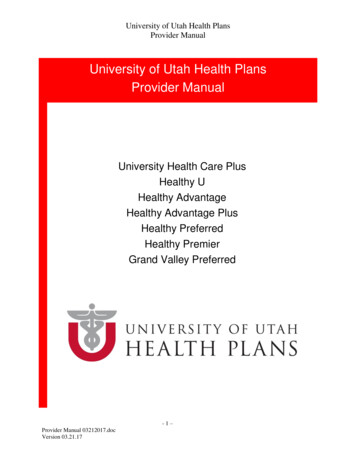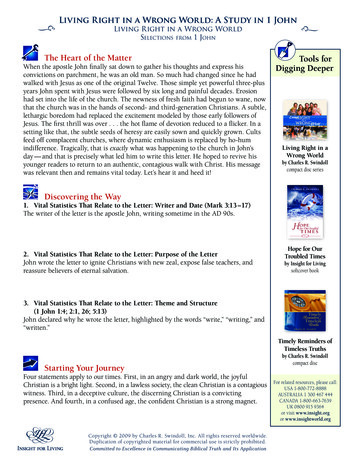
Transcription
LivingHealthywithDiabetesA guidefor adults55 and up
Living Healthywith DiabetesAs people get older, their riskfor type 2 diabetes increases.In fact, in the United Statesabout one in four people overthe age of 60 has diabetes.If you already have diabetes,you may find that you need toadjust how you manage yourcondition as the years go by.This booklet provides information to help you take careof your diabetes over the longterm, so that you can avoid ordelay complications and live along, happy, and active life.DiabetesBasicsWhat is type 2diabetes?When you eat, your food isbroken down into a sugarcalled glucose. Glucosegives your body the energyit needs to work. But touse glucose as energy, yourbody makes insulin, which“unlocks” your body’s cellsso they can receive theglucose they need.2A guide for adults 55 and upContents:Diabetes Basics . 2Healthy Food Choices . 4Physical Activity . 10Medicine for Diabetes . 12What to Expect at Your Doctor Visits . 14Traveling with Diabetes . 20Preventing and Treating Complications . 22Paying for Healthcare . 26For Caregivers . 28Resources . 30When you have type 2 diabetes,your body does not make enoughinsulin or use it well. This meansyour cells can’t use the glucoseas energy, so the glucose stays inyour blood. Having high blood glucose can cause problems like eye,kidney, nerve, and foot disorders.People with diabetes are also athigher risk for high blood pressure,heart disease and stroke, and otherserious conditions.There is no cure for diabetes, butit can be managed. Balancing thefood you eat with exercise andmedicine (if prescribed) will helpyou control your weight and cankeep your blood glucose in thehealthy range. This can help prevent or delay diabetes complica-tions. Many people with diabeteslive long and healthful lives.Taking care of yourdiabetesYour diabetes care team will helpyou, but day-to-day diabetes careis up to you. Day-to-daycare includes: Choosing what, how much,and when to eat Getting active Checking your blood glucose(if your doctor tells you to) Taking medicine (if yourdoctor prescribes it) Quitting smoking Going to your medicalappointments Learning all you can about diabetesLivingHealthywithDiabetesWho’s on my diabetes care team?Your diabetes care team may include a doctor, nurse,registered dietitian, pharmacist, diabetes educator andany other health care provider working to help you care foryour diabetes. (See page 18 for a sheet where you can trackall their contact information.) Your family and friends areimportant members of your team, too. But remember: Youare the captain of this team.3
Living Healthywith DiabetesAs people get older, their riskfor type 2 diabetes increases.In fact, in the United Statesabout one in four people overthe age of 60 has diabetes.If you already have diabetes,you may find that you need toadjust how you manage yourcondition as the years go by.This booklet provides information to help you take careof your diabetes over the longterm, so that you can avoid ordelay complications and live along, happy, and active life.DiabetesBasicsWhat is type 2diabetes?When you eat, your food isbroken down into a sugarcalled glucose. Glucosegives your body the energyit needs to work. But touse glucose as energy, yourbody makes insulin, which“unlocks” your body’s cellsso they can receive theglucose they need.2A guide for adults 55 and upContents:Diabetes Basics . 2Healthy Food Choices . 4Physical Activity . 10Medicine for Diabetes . 12What to Expect at Your Doctor Visits . 14Traveling with Diabetes . 20Preventing and Treating Complications . 22Paying for Healthcare . 26For Caregivers . 28Resources . 30When you have type 2 diabetes,your body does not make enoughinsulin or use it well. This meansyour cells can’t use the glucoseas energy, so the glucose stays inyour blood. Having high blood glucose can cause problems like eye,kidney, nerve, and foot disorders.People with diabetes are also athigher risk for high blood pressure,heart disease and stroke, and otherserious conditions.There is no cure for diabetes, butit can be managed. Balancing thefood you eat with exercise andmedicine (if prescribed) will helpyou control your weight and cankeep your blood glucose in thehealthy range. This can help prevent or delay diabetes complica-tions. Many people with diabeteslive long and healthful lives.Taking care of yourdiabetesYour diabetes care team will helpyou, but day-to-day diabetes careis up to you. Day-to-daycare includes: Choosing what, how much,and when to eat Getting active Checking your blood glucose(if your doctor tells you to) Taking medicine (if yourdoctor prescribes it) Quitting smoking Going to your medicalappointments Learning all you can about diabetesLivingHealthywithDiabetesWho’s on my diabetes care team?Your diabetes care team may include a doctor, nurse,registered dietitian, pharmacist, diabetes educator andany other health care provider working to help you care foryour diabetes. (See page 18 for a sheet where you can trackall their contact information.) Your family and friends areimportant members of your team, too. But remember: Youare the captain of this team.3
HealthyFood ChoicesChoosing what, how much,and when to eatIn the past, diets for people withdiabetes were very restrictive.Things are different now. There isn’ta “one size fits all” diabetes diet.While you may need to make somechanges in what and how much youeat, you have flexibility in decidingwhat’s on the menu. With a littleplanning, you can still include yourfavorite foods.A great way to begin meal planningis the “Plate Method”. Look at theCreate Your Plate graphic on pages6 and 7 to learn more. You can use itanytime whether you are cookingfor yourself or eating away fromhome.Once you’ve changed how muchyou are eating, you can start tomake healthier choices for eachtype of food. Focus on gettingenough non-starchy vegetablesand less starchy foods and meats.The Plate Method also shows youhow to fit fruit, low-fat dairy, andwhole grains into your meals. Keepmeals healthy and limit added fats,sugars, and sodium (salt).Practical food tips wheneating away from homeLivingHealthywithDiabetesVitamin D:Older Americansare not gettingenough vitamin D.Make sure the dairyand soy productsyou consume arevitamin D-fortified.Ask your doctorif you should betaking a supplement. Start your meal with abroth-based soup or a salad. Ask for sauces and dressingson the side. Choose vegetable or fruit sidedishes. Use the Plate Method. When your order arrives, divideportions before you start to eat.Take the extras home and savethem for another meal. Try to avoid buffets andall-you-can-eat deals. If you want dessert, split itwith friends or family.45
HealthyFood ChoicesChoosing what, how much,and when to eatIn the past, diets for people withdiabetes were very restrictive.Things are different now. There isn’ta “one size fits all” diabetes diet.While you may need to make somechanges in what and how much youeat, you have flexibility in decidingwhat’s on the menu. With a littleplanning, you can still include yourfavorite foods.A great way to begin meal planningis the “Plate Method”. Look at theCreate Your Plate graphic on pages6 and 7 to learn more. You can use itanytime whether you are cookingfor yourself or eating away fromhome.Once you’ve changed how muchyou are eating, you can start tomake healthier choices for eachtype of food. Focus on gettingenough non-starchy vegetablesand less starchy foods and meats.The Plate Method also shows youhow to fit fruit, low-fat dairy, andwhole grains into your meals. Keepmeals healthy and limit added fats,sugars, and sodium (salt).Practical food tips wheneating away from homeLivingHealthywithDiabetesVitamin D:Older Americansare not gettingenough vitamin D.Make sure the dairyand soy productsyou consume arevitamin D-fortified.Ask your doctorif you should betaking a supplement. Start your meal with abroth-based soup or a salad. Ask for sauces and dressingson the side. Choose vegetable or fruit sidedishes. Use the Plate Method. When your order arrives, divideportions before you start to eat.Take the extras home and savethem for another meal. Try to avoid buffets andall-you-can-eat deals. If you want dessert, split itwith friends or family.45
CreateYourPlate!1Imagine drawing a line downthe middle of your dinnerplate. Then on one side, cutit again so you will have 3sections on your plate like thepicture on your right.the largest section with2 Fillnon-starchy vegetables likesalad, green beans, broccoli,cauliflower, cabbage, carrots,and tomatoes.in one of the smaller3 Nowsections, put starchy foodsGrains and Starchy VegetablesMilkFruit whole grain breads or crackers whole grain, high-fiber cereal oatmeal, grits, hominy,or cream of wheat rice, pasta, tortillas cooked beans and peas potatoes, corn, winter squash skim, 1/2%, or 1% milk low-fat or fat-free yogurt plain soy milk fresh, frozen, orcanned in juiceor light syrup*For the platemethod, yourfood can bepiled about thethickness of adeck of cardsor the palm ofyour hand. Usea 9-inch platelike the oneshown here.such as noodles, rice, corn, orpotatoes.4The other small section is formeat, fish, chicken, eggs, ortofu.an 8 oz glass of milk and5 Addone small piece of fruit or 1/2cup of fruit salad and you’vegot a great meal. (If youdon’t drink milk, you can addan extra piece of fruit, lightyogurt, or a small roll.)6Protein chickenor turkey(withoutthe skin) fish shellfish lean cuts of beefand pork suchas sirloin or pork loin tofu, eggs, low-fat cheeseNon-StarchyVegetables fresh, frozen,or cannedcarrots,leafy greens,green , salsa,onion,cucumber,beets, okra,mushrooms,peppers, turnip7
CreateYourPlate!1Imagine drawing a line downthe middle of your dinnerplate. Then on one side, cutit again so you will have 3sections on your plate like thepicture on your right.the largest section with2 Fillnon-starchy vegetables likesalad, green beans, broccoli,cauliflower, cabbage, carrots,and tomatoes.in one of the smaller3 Nowsections, put starchy foodsGrains and Starchy VegetablesMilkFruit whole grain breads or crackers whole grain, high-fiber cereal oatmeal, grits, hominy,or cream of wheat rice, pasta, tortillas cooked beans and peas potatoes, corn, winter squash skim, 1/2%, or 1% milk low-fat or fat-free yogurt plain soy milk fresh, frozen, orcanned in juiceor light syrup*For the platemethod, yourfood can bepiled about thethickness of adeck of cardsor the palm ofyour hand. Usea 9-inch platelike the oneshown here.such as noodles, rice, corn, orpotatoes.4The other small section is formeat, fish, chicken, eggs, ortofu.an 8 oz glass of milk and5 Addone small piece of fruit or 1/2cup of fruit salad and you’vegot a great meal. (If youdon’t drink milk, you can addan extra piece of fruit, lightyogurt, or a small roll.)6Protein chickenor turkey(withoutthe skin) fish shellfish lean cuts of beefand pork suchas sirloin or pork loin tofu, eggs, low-fat cheeseNon-StarchyVegetables fresh, frozen,or cannedcarrots,leafy greens,green , salsa,onion,cucumber,beets, okra,mushrooms,peppers, turnip7
Your weightIf you are overweight, losingweight can help improve yourdiabetes management. You don’thave to lose a lot of weight to startseeing results. Just 10 to 15 poundscan make a difference.There are many types of weightloss plans to choose from. Eventhe Plate Method can help withweight loss. The key to losingweight in a healthy way is to do sogradually. Avoid extreme diets, andabove all, follow the guidance ofyour doctor or dietitian to createa diet that will work for you.Changes in tasteYou may notice that yoursense of taste has changedover time. Some medicinescan make food tastedifferent. If you are havingtrouble with the flavors ofyour foods, try cooking withmore herbs and spices toadd flavor. But avoid addingextra salt, which can causeyour blood pressure to rise.LivingHealthywithDiabetesCommunity Food ProgramsMany communities have programs for seniors,including: Congregate (or Group) Meals: Often foundin senior centers, churches, and schools.These programs are a great way to meet andsocialize while eating a healthy meal. Home-Delivered Nutrition Services: Thisprogram (also known as “Meals on Wheels”)delivers healthy meals to people who arehomebound. Senior Farmer’s Market Nutrition Program(SFMNP): This program provides couponsto lower-income seniors for certain foodsat farmers markets, roadside stands, andcommunity supported agriculture programs.To find out if you qualify, contact your stateagency listed at: ts.htm Supplemental Nutrition Assistance Program(SNAP): Formerly called the Food StampProgram, SNAP provides a monthly foodsubsidy to people of all ages who qualify. Goto: http://www.fns.usda.gov/snap/ to figureout if you are eligible.Your local Area Agency on Aging (see page 30)can offer more information on these programs.89
Your weightIf you are overweight, losingweight can help improve yourdiabetes management. You don’thave to lose a lot of weight to startseeing results. Just 10 to 15 poundscan make a difference.There are many types of weightloss plans to choose from. Eventhe Plate Method can help withweight loss. The key to losingweight in a healthy way is to do sogradually. Avoid extreme diets, andabove all, follow the guidance ofyour doctor or dietitian to createa diet that will work for you.Changes in tasteYou may notice that yoursense of taste has changedover time. Some medicinescan make food tastedifferent. If you are havingtrouble with the flavors ofyour foods, try cooking withmore herbs and spices toadd flavor. But avoid addingextra salt, which can causeyour blood pressure to rise.LivingHealthywithDiabetesCommunity Food ProgramsMany communities have programs for seniors,including: Congregate (or Group) Meals: Often foundin senior centers, churches, and schools.These programs are a great way to meet andsocialize while eating a healthy meal. Home-Delivered Nutrition Services: Thisprogram (also known as “Meals on Wheels”)delivers healthy meals to people who arehomebound. Senior Farmer’s Market Nutrition Program(SFMNP): This program provides couponsto lower-income seniors for certain foodsat farmers markets, roadside stands, andcommunity supported agriculture programs.To find out if you qualify, contact your stateagency listed at: ts.htm Supplemental Nutrition Assistance Program(SNAP): Formerly called the Food StampProgram, SNAP provides a monthly foodsubsidy to people of all ages who qualify. Goto: http://www.fns.usda.gov/snap/ to figureout if you are eligible.Your local Area Agency on Aging (see page 30)can offer more information on these programs.89
Physical ActivityBeing active is another part of livinghealthy and managing diabetes. Anytype of physical activity you do willhelp lower your blood glucose.Other benefits include: Improving your A1C, bloodpressure, and cholesterol Having more energy Relieving stress Burning calories to help youlose or maintain your weight Keeping your joints flexible Increasing your strength Improving your balance toprevent falls Lowering your risk for heartdisease and strokeTypes of physical activityAny activity you do is helpful, soyou may as well do things that youenjoy. Exercise with friends andfamily for even more fun. There arefour main categories of activity thatall provide important benefits:Aerobic exercise helps to keepyour heart strong. Aim to do 30minutes at least 5 times a week.Start slowly! Walking Aerobics (floor, water, or chairaerobics) Bicycling Tennis Dancing Gardening Playing with grandchildren Swimming Raking leaves Golfing (walk the course!)Strength training helps tomaintain and build muscle. Try to dostrength exercises at least twice aweek. Lifting free weights/using weightmachines Using resistance bands Climbing stairs Calisthenics (this includespush-ups, pull-ups, sit-ups) Carrying groceries Gardening (like digging orhoeing) Doing yoga and tai chi exercises10Stretching helps you stay flexible and prevent stiffness. Stretchas often as you can. Basic stretches Yoga PilatesBalance exercises help youstay steady on your feet. They areespecially important as you getolder. Do balance exercises 3 ormore days a week. Walking backwards or sideways Walking heel to toe in a straightline Standing on one foot Standing from a sitting positionExercise andblood glucoseHow exercise affects your bloodglucose will vary depending onhow long you are active and otherfactors. If you take insulin or somediabetes pills, there are a fewthings you should do to preventlow blood glucose (hypoglycemia)when you exercise.You can check your blood glucosebefore exercising. If it is under 100mg/dl, eat some fruit, crackers, orhave a glass of milk or juice. Checkit again after exercising to learnhow your blood glucose reactsto exercise. Bring a snack if you’llbe out and moving for severalhours.Safe exerciseYou should warm up, stretch, andcool down to prevent injuries. Ifyou are not active right now, youneed to start slowly. You shouldbe able to talk while you are exercising to make sure you aren’tworking too hard. If you have othermedical conditions or diabetescomplications, talk to your doctor before increasing your activity.He or she will tell you what kind ofactivity is safe for you.Once you can exercise for 10 minutes at a low intensity, add a fewminutes each day until you are atyour goal. For most people, walking is a good way to start. If youhave trouble walking, try activitieslike swimming, chair exercise classes, or using a stationary bike.Does 30 minutessound too longfor your busyschedule?LivingHealthyNo problem! ThreewithDiabetes10-minute spurts ofactivity throughout theday are just as good asone 30-minute session.11
Physical ActivityBeing active is another part of livinghealthy and managing diabetes. Anytype of physical activity you do willhelp lower your blood glucose.Other benefits include: Improving your A1C, bloodpressure, and cholesterol Having more energy Relieving stress Burning calories to help youlose or maintain your weight Keeping your joints flexible Increasing your strength Improving your balance toprevent falls Lowering your risk for heartdisease and strokeTypes of physical activityAny activity you do is helpful, soyou may as well do things that youenjoy. Exercise with friends andfamily for even more fun. There arefour main categories of activity thatall provide important benefits:Aerobic exercise helps to keepyour heart strong. Aim to do 30minutes at least 5 times a week.Start slowly! Walking Aerobics (floor, water, or chairaerobics) Bicycling Tennis Dancing Gardening Playing with grandchildren Swimming Raking leaves Golfing (walk the course!)Strength training helps tomaintain and build muscle. Try to dostrength exercises at least twice aweek. Lifting free weights/using weightmachines Using resistance bands Climbing stairs Calisthenics (this includespush-ups, pull-ups, sit-ups) Carrying groceries Gardening (like digging orhoeing) Doing yoga and tai chi exercises10Stretching helps you stay flexible and prevent stiffness. Stretchas often as you can. Basic stretches Yoga PilatesBalance exercises help youstay steady on your feet. They areespecially important as you getolder. Do balance exercises 3 ormore days a week. Walking backwards or sideways Walking heel to toe in a straightline Standing on one foot Standing from a sitting positionExercise andblood glucoseHow exercise affects your bloodglucose will vary depending onhow long you are active and otherfactors. If you take insulin or somediabetes pills, there are a fewthings you should do to preventlow blood glucose (hypoglycemia)when you exercise.You can check your blood glucosebefore exercising. If it is under 100mg/dl, eat some fruit, crackers, orhave a glass of milk or juice. Checkit again after exercising to learnhow your blood glucose reactsto exercise. Bring a snack if you’llbe out and moving for severalhours.Safe exerciseYou should warm up, stretch, andcool down to prevent injuries. Ifyou are not active right now, youneed to start slowly. You shouldbe able to talk while you are exercising to make sure you aren’tworking too hard. If you have othermedical conditions or diabetescomplications, talk to your doctor before increasing your activity.He or she will tell you what kind ofactivity is safe for you.Once you can exercise for 10 minutes at a low intensity, add a fewminutes each day until you are atyour goal. For most people, walking is a good way to start. If youhave trouble walking, try activitieslike swimming, chair exercise classes, or using a stationary bike.Does 30 minutessound too longfor your busyschedule?LivingHealthyNo problem! ThreewithDiabetes10-minute spurts ofactivity throughout theday are just as good asone 30-minute session.11
Medicinefor DiabetesDiabetes PillsThere are many different typesof diabetes pills. Each type of pillworks differently to help loweryour blood glucose. You may needto take more than one becausesometimes drugs work evenbetter when taken together.DietarySupplementsTaking a multivitamin canhelp fill nutrient gaps in yourdiet, but should not be usedas a substitute for healthyfoods. It is very importantto talk to your doctorabout any vitamins orsupplements that you use.Some can interfere withyour other medicines andsome may be unnecessary.InsulinMany people with type 2 need insulin as time goes on. This is becausethe body makes less insulin overtime. It doesn’t mean your condition is worse or that you are doingsomething wrong. When you havehad diabetes for a while, insulinmay become the treatment youneed to reach your A1C goal so youfeel better and stay healthy. Insulincannot be taken as a pill. It must beinjected or given through a pump.SpecialSuppliesLivingHealthywithDiabetesIf you have troubleopening small pillboxes, there are larger,easy-to-open pill boxesavailable. Some otherspecial supplies includemagnifiers for readingmedicine labels andblood glucose metersthat “talk”. If you usereminder alarms foryour medicine and alsohave trouble hearing,try an alarm with avibration feature.12Keeping Trackof MedicinesYou may be taking a pill or insulinfor your diabetes plus pills forother conditions like high bloodpressure and high cholesterol.With a pill for this and a pill forthat, keeping track can be a lot ofwork. Stay on top of your medicineschedule: Keep an updated list of yourmedicines (prescription, nonprescription, dietary supplementsincluding vitamins, and herbalremedies). Record importantinformation about each medicine.The chart on page 17 can helpyou get started. Take all of your medicines exactlyas your doctor tells you. Use one pharmacy to fill all yourprescriptions if possible. Keep medicines in a cool, dryplace. Use a pill organizer. Use a reminder timer, an alarmclock, or your mobile phonealarm to remind you when to takemedicine. Link pill-taking to something inyour daily routine (for example,take your medicine right afteryou brush your teeth). Use a chart or dry erase board tokeep track of your pill-taking.13
Medicinefor DiabetesDiabetes PillsThere are many different typesof diabetes pills. Each type of pillworks differently to help loweryour blood glucose. You may needto take more than one becausesometimes drugs work evenbetter when taken together.DietarySupplementsTaking a multivitamin canhelp fill nutrient gaps in yourdiet, but should not be usedas a substitute for healthyfoods. It is very importantto talk to your doctorabout any vitamins orsupplements that you use.Some can interfere withyour other medicines andsome may be unnecessary.InsulinMany people with type 2 need insulin as time goes on. This is becausethe body makes less insulin overtime. It doesn’t mean your condition is worse or that you are doingsomething wrong. When you havehad diabetes for a while, insulinmay become the treatment youneed to reach your A1C goal so youfeel better and stay healthy. Insulincannot be taken as a pill. It must beinjected or given through a pump.SpecialSuppliesLivingHealthywithDiabetesIf you have troubleopening small pillboxes, there are larger,easy-to-open pill boxesavailable. Some otherspecial supplies includemagnifiers for readingmedicine labels andblood glucose metersthat “talk”. If you usereminder alarms foryour medicine and alsohave trouble hearing,try an alarm with avibration feature.12Keeping Trackof MedicinesYou may be taking a pill or insulinfor your diabetes plus pills forother conditions like high bloodpressure and high cholesterol.With a pill for this and a pill forthat, keeping track can be a lot ofwork. Stay on top of your medicineschedule: Keep an updated list of yourmedicines (prescription, nonprescription, dietary supplementsincluding vitamins, and herbalremedies). Record importantinformation about each medicine.The chart on page 17 can helpyou get started. Take all of your medicines exactlyas your doctor tells you. Use one pharmacy to fill all yourprescriptions if possible. Keep medicines in a cool, dryplace. Use a pill organizer. Use a reminder timer, an alarmclock, or your mobile phonealarm to remind you when to takemedicine. Link pill-taking to something inyour daily routine (for example,take your medicine right afteryou brush your teeth). Use a chart or dry erase board tokeep track of your pill-taking.13
What toExpect at YourDoctor VisitsThere are several basic tests thatcan help you and your doctormonitor the effectiveness of yourmanagement regimen. Use thechart on page 18 to keep trackof the goals you and your doctorset.AlC – Tells you what your averageblood glucose level has been overthe past 2-3 months. A1C can alsobe reported as Estimated AverageGlucose, or eAG.Blood Pressure – Measures theforce of your blood in your vessels.Be prepared foryour visit.Lipids – Lipids are blood fats.There are three main kinds oflipids. Write down your questionsbeforehand and bring them inwith you. See page 19 for a listof questions to ask about yourmedicines. Bring paper and a pen with youto take notes. Consider bringing a friend orfamily member with you too.They can help you keep track ofimportant instructions. Bring all of your pill bottles,over-the-counter medicines,vitamins, and herbal remedieswith you. Show them to yourdoctor to make sure that all ofyour medicines work together. If you do not want to bringeverything in, bring a completelist of important informationabout your medicines. HDL: High density lipoproteinor “good” cholesterol LDL: Low density lipoprotein,or “bad” cholesterol Triglycerides: Another “bad” fatthat can build up in blood andblock arteries.Weight – Check your weight ateach office visit to see if you aremeeting your goal.Urine Albumin – Measures howwell your kidneys are working.Foot Exams – Take your shoes offat every office visit. Ask your doctor to take a look for any redness,blisters, or cuts on your feet. Yourdoctor will do a full foot exam tocheck for signs of nerve damageat least once a year.Flu ShotGet one everyyear from yourdoctor or aclinic near you.14We have included a charton page 17 to help you keeptrack of your medicines.Pneumonia shotMake sure you have had a pneumoniashot. You may need a second shot whenyou turn 65 or if you have other healthissues, so be sure to ask your doctor.15
What toExpect at YourDoctor VisitsThere are several basic tests thatcan help you and your doctormonitor the effectiveness of yourmanagement regimen. Use thechart on page 18 to keep trackof the goals you and your doctorset.AlC – Tells you what your averageblood glucose level has been overthe past 2-3 months. A1C can alsobe reported as Estimated AverageGlucose, or eAG.Blood Pressure – Measures theforce of your blood in your vessels.Be prepared foryour visit.Lipids – Lipids are blood fats.There are three main kinds oflipids. Write down your questionsbeforehand and bring them inwith you. See page 19 for a listof questions to ask about yourmedicines. Bring paper and a pen with youto take notes. Consider bringing a friend orfamily member with you too.They can help you keep track ofimportant instructions. Bring all of your pill bottles,over-the-counter medicines,vitamins, and herbal remedieswith you. Show them to yourdoctor to make sure that all ofyour medicines work together. If you do not want to bringeverything in, bring a completelist of important informationabout your medicines. HDL: High density lipoproteinor “good” cholesterol LDL: Low density lipoprotein,or “bad” cholesterol Triglycerides: Another “bad” fatthat can build up in blood andblock arteries.Weight – Check your weight ateach office visit to see if you aremeeting your goal.Urine Albumin – Measures howwell your kidneys are working.Foot Exams – Take your shoes offat every office visit. Ask your doctor to take a look for any redness,blisters, or cuts on your feet. Yourdoctor will do a full foot exam tocheck for signs of nerve damageat least once a year.Flu ShotGet one everyyear from yourdoctor or aclinic near you.14We have included a charton page 17 to help you keeptrack of your medicines
live long and healthful lives. taking care of your diabetes Your diabetes care team will help you, but day-to-day diabetes care is up to you. Day-to-day care includes: Choosing what, how much, and when to eat Getting active Checking your blood glucose (if your doctor tells











